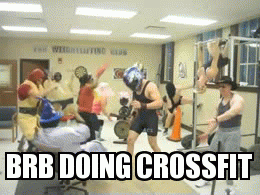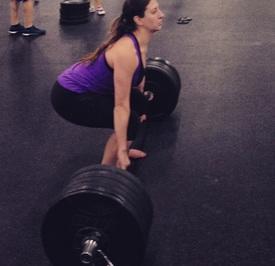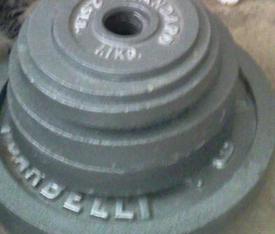Crossfit a Load of Shizzdoodles
Replies
-
I could say a lot about the subject, but I could never say it better that the owner of the gym I used to train at. Without further ado, I give you Mark Rippetoe's take on the matter:
Crossfit: The Good, The Bad, The Ugly
By Mark Rippetoe
Here's what you need to know...
• CrossFit has done an incredibly good job at popularizing tough training using barbells.
• CrossFit is fine "Exercise" but it's not "Training." The undoubtedly impressive CrossFit Games athletes don't use CrossFit programming.
• There are good and bad CrossFit coaches, but the certification farm CrossFit has become often produces more bad than good.
I was associated with CrossFit for about three years beginning in 2006, providing weekend seminars and instructional videos that demonstrated technique on the five basic barbell exercises. I ended my formal association with the organization in 2009 due to ideological and personal differences, and The Aasgaard Company started our own seminar product in January of 2010.
During this seven-year period of time I've become quite familiar with the system and the people who developed it, I've watched it change significantly over these years, and I've come to hold several opinions regarding CrossFit. Some of them I will share with you here.
The Good
CrossFit is the greatest thing that has ever happened to barbell training, bar none, unequivocally and absolutely.
Since the invention of the equipment a hundred years ago, nothing has placed more hands on more barbells than CrossFit. This is what motivated my involvement with them in 2006 - I saw a huge amount of potential for the advancement of strength training.
Now, it must be said that P90X broke the ground with their infomercials, the first of their kind, showing people getting results with exercise that was actually hard. Previously, the primary criterion for exercise advertised on TV was that the DynoIsoThighMaster2000 folded up and stored under your bed. It was fun and took five minutes a week. And it was easy.
So P90X comes along and says that you have to get sweaty and tired if you want to get stronger and lose bodyfat, and it will help if you do their diet too. After a period of development that began in 2002, they started airing millions of infomercials in 2004, and within a couple of years every human being on Earth had been exposed to the idea that "hard" was productive, and that muscles needed to be "confused," an idea first popularized by the Weider organization in the '70s. With the broad general public exposed to the ideas of "hard" and "random/muscle confusion," the field had been plowed.
CrossFit began to get popular about this time. It has been called "P90X with barbells" -- it confuses the muscles with random exposure to a variety of movements and equipment that P90X does not use, and it is very hard. CrossFit had an appeal that has subsequently ballooned into the fastest-growing business opportunity for gym owners in the history of the industry.
Each of these gyms (I'm sorry, but I cannot call them "boxes") has bars, bumper plates, racks of some sort, and the platform space to do the basic exercises that comprise effective strength training. And each of them also offers a place to do the WOD that all the other CrossFitters around the world are doing that day. But if they'll let you, each gym also is a place where you can do very productive strength training.
CrossFit also constitutes nothing less than a total revolution in the potential for the development of Olympic weightlifting in the United States, so far in excess of Bob Hoffman's wildest dreams that the English language fails to describe its importance.
For example, in 2004 there was one place to do the snatch and the clean & jerk in the entire Dallas Ft. Worth Metroplex: Tom Witherspoon's garage. Before, six million people/Tom Witherspoon's garage. Now, 10 years later, there are no less than 40 CrossFit affiliates - probably 41, since I've been typing a while. USA Weightlifting has yet to capitalize on this unique opportunity, for reasons beyond the scope of this article. Nonetheless, the amazing opportunity remains in place.
So, no matter what other derogatory stuff I or anybody else says about it, CrossFit has provided more people with access to barbells and the motivation to lift them than any other single factor in the past hundred years. Our company (Aasgaard), Rogue Fitness, York Barbell, Lululemon, Robb Wolf, ten or so shoe companies and chalk and tape manufacturers, several dozen Olympic weightlifting coaches, hundreds of grass-fed beef suppliers, and tens of thousands of commercial space landlords have all benefited from the existence and phenomenal expansion of CrossFit.
We will all be forever grateful for the work.
The Bad
CrossFit - the program on the website and the methods taught at their "certs" -- is Exercise, not Training. Exercise is physical activity for its own sake, a workout done for the effect it produces today, during the workout or right after you're through. Training is physical activity done with a longer-term goal in mind, the constituent workouts of which are specifically designed to produce that goal.
Exercise is fun today. Well, it may not be fun, but you've convinced yourself to do it today because you perceive that the effect you produce today is of benefit to you today. You "smashed" or "crushed" or "smoked" that workout... today. Same as the kids in front of the dumbbell rack at the gym catching an arm pump, the workout was about how it made you feel, good or bad, today.
In contrast, Training is about the process you undertake to generate a specific result later, maybe much later, the workouts of which are merely the constituents of the process. Training may even involve a light day that you perceive to be a waste of time if you only consider today.
CrossFit is a random exposure to a variety of different movements at different intensities, most of which are done for time, i.e., as many reps as possible in a stipulated time period or a stipulated number of reps done as fast as possible. As such, it is Exercise, not Training, since it is random, and Training requires that we plan what we are going to do to get ready for a specific task.
Different physical tasks require different physical adaptations; running 26.2 miles is obviously a different task than squatting 700 pounds, and the two efforts require completely different physical adaptations. If a program of physical activity is not designed to get you stronger or faster or better conditioned by producing a specific stress to which a specific desirable adaptation can occur, you don't get to call it training. It is just exercise.
For most people, exercise is perfectly adequate -- it's certainly better than sitting on your *kitten*. For people who perceive themselves as merely housewives, salesmen, or corporate execs, and for most personal training clients and pretty much everybody who can afford a CrossFit membership, exercise is fine. CrossFit sells itself by advertising the random part: random is not boring, and not-boring gets people to come back. Coming back while doing the diet at the same time gets you abs. CrossFit is largely about abs.
CrossFit is also about the concept of "community" -- the reinforcement of behavior through group participation and group approval. I understand this quite intimately, because I have met some of the best people I have ever known through CrossFit, the vast majority of whom are still friends even though I'm no longer associated with CrossFit formally. A better-than-average group of people that likes you and helps you be better is a very powerful motivator for improvement, and CrossFit: The Community provides this in abundance.
These two very powerful motivating factors -- non-boring and in-group social dynamics -- working together, do the best job of reinforcing workout adherence that has ever been brought to play in the fitness industry. In fact, CrossFit operates, in this important respect, in a way that is completely opposite to the industry paradigm of sell-'em-and-run-'em-off.
But this active retainment of members actually using the gym creates a unique problem for CrossFit facilities that no one else in the standard fitness industry has to face: the post-novice trainee.
As you are obviously aware (since you have memorized my books), a novice trainee is one for whom recovery from each workout is possible within a very short time frame -- 48 hours or so. This is because untrained people are unadapted people, and for unadapted people anything that's harder than what they've been doing causes an adaptation.
This is why CrossFit works so well for the vast majority of the people that start it: for the first time, an exercise program causes them to experience rapid improvement... at first. Then the problem with CrossFit becomes obvious.
CrossFit is not Training. It is Exercise. And exercise -- even poorly-programmed random flailing-around in the floor for time -- causes progress to occur, for a while. For the novice, CrossFit Exercise mimics the effects of Training, because it's hard and because stress causes adaptation. Then, progress slows, since the Laws of Physiology cannot be ignored. The more you adapt to physical stress, the stronger and fitter you become. And the stronger and fitter you become, the more difficult it is to get more strong and more fit, because the easy part of the process has already occurred.
This is called the Principle of Diminishing Returns, and is evident throughout nature and your own experiences, if you have paid attention. Once the low-hanging fruit have been picked, you have to get a ladder, and then you might need a helicopter -- and each increase in complexity yields less fruit, damnit.
And this is precisely where CrossFit: The Methodology falls apart. Once a person has adapted beyond the ability of random stress applied frequently under time constraints to cause further improvement, progress stalls. And increasing the intensity of the random stress doesn't work either -- that just gets you hurt because you haven't gotten stronger, and your heart and lungs can only work at about 200 BPM and about 50 RPM.
Further progress must be based on an analysis of the adaptation you want to create, and a program of Training for the purpose of causing that adaptation to occur must be correctly designed and followed. Beyond a certain point, random physical stress fails to continue to elicit a favorable adaptation.
CrossFit appeals to many people because it claims to be about doing everything well and nothing perfectly. Humans cannot excel at everything, as evidenced by the individual performances within the Decathlon as compared to the specialists' performances in those events. But at some point, even people who don't want to excel at anything in particular realize they aren't really improving at anything in general. People motivated to get this far are also motivated to continue improving, and even if you want to be merely good at everything, there must be a way to continue to improve this general competence. "Mainsite CrossFit" cannot drive this improvement beyond a certain point.
This is precisely why the advanced athletes who win and place at the CrossFit Games do not use CrossFit website programming to achieve advanced levels of the strength and conditioning necessary to perform at that level. None of them. This is widely known and freely admitted by everyone not involved with the company. All athletes at advanced levels must Train intelligently to advance, and CrossFit: The Methodology doesn't do the job.
Strength is an excellent example of a physical characteristic that drives improvement in other athletic parameters. More strength means more power, more endurance, better coordination, and better everything else. This is why, all other things being equal, the stronger athlete is the better athlete.
You can get stronger for a while doing random exercise, but everyone who has tried it knows that at some point you have to put more weight on the bar and lift it on a regular, programmed basis that obeys the rules of adaptive physiology and logic. You have to plan to get stronger by doing things that require that you be stronger, while not doing things that interfere with the process. Random WOD CrossFit is not good at making this happen -- or even allowing it to happen.
So, the program that's very good at getting people to stay involved is also very good at getting people to the point where the same random exposure to hard physical stress no longer works, and must become non-random in order that progress continues to be made. For many CrossFitters, exercise will always be enough. But for many others, CrossFit takes them to the point where CrossFit isn't good enough anymore. For them, Exercise leads to Training, and CrossFit is merely Exercise.
In other words, CrossFit has an inherent problem that it cannot seem to solve.
The Ugly
Why can't CrossFit: The Business Model solve the problem? Because it doesn't want to. Hell, it doesn't need to: at eight to ten completely sold-out Level I "certs" every weekend, each of which may enroll 50 participants at $1000 each, it would be very difficult to convince any sane person that CrossFit has any problems at all.
Here's one aspect of the problem: how many of these approximately 500 people failed? How many certified CF Level I "coaches" are actually qualified to coach CrossFit or anything else? How many have the experience to understand The Bad -- the limitations of WOD programming -- and how to correct it?
Any organization which grows this fast will have problems. Among the more serious problems that CrossFit has are the injuries. Shoulders, Achilles tendons, rhabdomyolysis, and all the other things that are the potential result of overtraining an athlete who cannot continue to adapt to randomly applied and sometimes very intense physical stress. These are potentially life-altering exposures to needless trauma that can be prevented by not doing stupid **** to people who don't know any better than to do what they're told.
NFL players get injured. So do almost all professional athletes. In fact, every competitive athlete faces the prospect of injury, because that is the price paid for shifting the focus from merely doing to winning. The risk/reward ratio has been calculated and allowed for.
CrossFitters get injured while exercising in the gym. Most are upset when this happens, but some of them regard these injuries as a marker of status -- as though the injury itself confers some elite level of athletic accomplishment to a set of pull-ups. It may be a torn callus or a torn cuff tendon -- any injury represents a setback in an actual training program, while for a CrossFitter it may be regarded as evidence that something wonderful has been achieved.
People working very hard at high-intensity high-volume physical tasks are going to get hurt, no matter why they're doing the work. One of the reasons that Training results in long-term improvement is that it properly assesses the current state of the athlete and logically plans for improvement in a way that is sustainable, safe, specific to the goal, and therefore productive. Random exposure to varying levels of volume, intensity, rest, technical complexity, and power output cannot be sustainable, safe, specific, and productive.
You know the Hamill study, published in the JSCR that evaluates the risk of injury in various athletic activities? The one that found that "weight training" was one of the safest activities in the spectrum? CrossFit actually has the potential to change this.
The Ugly is that some freshly-minted CrossFit coaches recognize this Training/Exercise problem, even if they can't articulate its cause, and attempt to address the situation by simply adding to the intensity. Adding weight to already fatiguing ballistic movements is dangerous, and you're not being a ***** if you recognize the fact that this is not always a good idea.
Weighted high-rep 24-inch box jumps for time are a potentially very dangerous dose of stress, from both a metabolic and structural perspective, made even more dangerous in combination with several other high-rep movements that can fatigue the athlete in the short-term and produce high levels of tendon and muscle inflammation in the long-term.
Is everybody who passed that CF Level I Cert last weekend actually capable of evaluating which of the people in the class should do this workout, even if they can?
The Ugly is that one of the best things that has ever happened to strength and conditioning is also one of the worst things that can happen to some very good people. People who are committed to you because you have shown them progress and because they are part of your group will do things because you tell them to. This is unfortunately true, people being people, and it has gotten some of them badly hurt.
A Coach is supposed to know better than to place people in a position to get hurt by asking them to do things they can't or shouldn't do. The fact that everybody all over the world is doing these things today should not matter to a Coach.
There are hundreds of very good CrossFit affiliates across the country and around the world, staffed by very good coaches with more-than-adequate experience and excellent judgement about all matters regarding exercise and training, which to use, and who to use it with. I know many of these people, and I can tell you with absolute certainty that they know what they're doing.
The Ugly is that there are many thousands of CrossFit affiliates around the world and hundreds of new "coaches" each weekend. Think about this very carefully.
this is a very reasonable take and it's helped solidify my thoughts on something that's been bothering me, but that i haven't been able to properly express w.r.t. to programs like P90X... the difference between "exercise" and "training".0 -
the price in the DC area is LUDICROUS. otherwise, i think i might enjoy it. but i won't be going paleo any time soon.
I CrossFit. I also eat ALL the foods.
that's encouraging, really. because everyone and their mothers who do crossfit around here prosthelytize the paleo diet. but honestly, if it was cheaper, i would totally jump on the bandwagon. be surrounded by other health-minded folk with glistening bodies (theirs, not mine, unless sweat counts)? CHECK AND CHECK.
I would join too! You can't deny that it gets results, I just can't afford it.0 -
I have never tried it so I can't comment....but the price is silly IMO.0
-
I've been doing Crossfit for under a month and have seen more improvement in my weight lifting and endurance than I have with anything else I've done in the past, ever (Stronglifts, running, general gym-ing...anything). That's not to say that it's not a bit cultish, but I think my form is much better than it's ever been and I'm able to do a lot more than I've ever been able to do. The group spirit (we're all in this together!) and ability to watch other persons do what we're meant to do, much better than I can do it, doesn't hurt either.
There are *kitten* and unqualified trainers everywhere, in and out of 'the box'. it's not a Crossfit thing so much as it is an industry thing. And people get injured no matter what they do, especially if they go too hard (which I think is Crossfit's biggest drawback from a safety perspective - that go hard or die mentality. I make a point not to overdo it and trust that it will happen when it happens, but I think my approach is different than most people's).
Also, my box is $75 which is much less than most group classes or gyms available in my country.
TL;DR nice troll post, next time just put up some pics of how bulkyyyy and mannish you've gotten doing NROLFW and not doing any muscle-wasting cardio. And everyone will congratulate you, and you can revel in how superior what you do is to what everyone else does. Much more gratifying.0 -
I have never tried it so I can't comment....but the price is silly IMO.
And yet....you commented...
$180 is at the very high end. My box isn't that much. But price is a dumb argument. Value is subjective. You may spend money on things I don't think are important, but they are important to YOU so that's all that matters to YOU.0 -
TL;DR nice troll post, next time just put up some pics of how bulkyyyy and mannish you've gotten doing NROLFW and not doing any muscle-wasting cardio. And everyone will congratulate you, and you can revel in how superior what you do is to what everyone else does. Much more gratifying.





I just swooned so hard I fell out of my chair. I caught the vapors!!0 -
Crossfit has done more to put barbells in the hands of average people than any other exercise modality to come before, so you shouldn't knock it. It's only "silly" if you have bad coaches at your local box and are unable to correctly gauge your own limitations.
I agree 100%.
I do like a lot of things about Crossfit, but the problem with it is the crappy programming (e.g. 2 miles runs followed by a zillion reps of Deadlifts or other very technical lifts like Power Cleans) and the lack of experience of a lot of the coaches.
I personally incorporate Crossfit WODs into my workout regime. That said, I'd never join a Crossfit Box for the reasons I stated above. Plus there's no way I'd pay $100+/month for what is essentially a glorified group exercise class. I also don't need the support of others to have a great workout, as I prefer to workout alone. But for some, these things are important, so to each their own.0 -
I enjoyed my time in crossfit. Was worth it for the rubberized floors and bumper plates alone...and the technique coaching was solid too. Hoping to get back into it this summer.
Anyhow, in...
...this obviously-troll thread.0 -
the price in the DC area is LUDICROUS. otherwise, i think i might enjoy it. but i won't be going paleo any time soon.
I CrossFit. I also eat ALL the foods.
that's encouraging, really. because everyone and their mothers who do crossfit around here prosthelytize the paleo diet. but honestly, if it was cheaper, i would totally jump on the bandwagon. be surrounded by other health-minded folk with glistening bodies (theirs, not mine, unless sweat counts)? CHECK AND CHECK.
Life without Peanut Butter is not a life worth living :laugh:0 -
I have never tried it so I can't comment....but the price is silly IMO.
And yet....you commented...
$180 is at the very high end. My box isn't that much. But price is a dumb argument. Value is subjective. You may spend money on things I don't think are important, but they are important to YOU so that's all that matters to YOU.
Boy, can't comment without someone completely biting your head off on here. Just relax.0 -
That never happens and is a gross exaggeration of actual CrossFit programming.I do like a lot of things about Crossfit, but the problem with it is the crappy programming (e.g. 2 miles runs followed by a zillion reps of Deadlifts or other very technical lifts like Power Cleans) and the lack of experience of a lot of the coaches.I personally incorporate Crossfit WODs into my workout regime. That said, I'd never join a Crossfit Box for the reasons I stated above. Plus there's no way I'd pay $100+/month for what is essentially a glorified group exercise class.
Eh, think of it more as a personal training session only there is more than just you and the trainer/coach. There is still quite a bit of one-on-one instruction and a good coach will always watch/critique your form as there is always room for improvement no matter how proficient you are.0 -
I cant wait to see if people will completely rip into me about this,
But seriously, who thinks Crossfit is one of the silliest, albeit most hilarious, things to enter the fitness world recently?!?!
If done right it's a super tool for endurance and strength. It's the yahoos who go overboard that give it a bad name.0 -
I cant wait to see if people will completely rip into me about this,
But seriously, who thinks Crossfit is one of the silliest, albeit most hilarious, things to enter the fitness world recently?!?!
Is your opinion based upon experience? If not, what is your source for understanding crossfit, Youtube?0 -
All I want to know is where they find those awesome bumper plates for the barbells.0
-
Crossfit has done more to put barbells in the hands of average people than any other exercise modality to come before, so you shouldn't knock it. It's only "silly" if you have bad coaches at your local box and are unable to correctly gauge your own limitations.
I agree 100%.
I do like a lot of things about Crossfit, but the problem with it is the crappy programming (e.g. 2 miles runs followed by a zillion reps of Deadlifts or other very technical lifts like Power Cleans) and the lack of experience of a lot of the coaches.
I personally incorporate Crossfit WODs into my workout regime. That said, I'd never join a Crossfit Box for the reasons I stated above. Plus there's no way I'd pay $100+/month for what is essentially a glorified group exercise class. I also don't need the support of others to have a great workout, as I prefer to workout alone. But for some, these things are important, so to each their own.
troof0 -
also, this seems an appropriate thread to post this (my 2nd favorite MFP GIF of all-time)...


ETA - no real offense intended to my crossfitting friends, merely a little good-natured teasing. 0
0 -
I incorporate crossfit work outs into my regimine- after my work sets of course and as assistance work- and I think they are pretty bomb.
But that's pretty much all i know about it.0 -
I do like a lot of things about Crossfit, but the problem with it is the crappy programming (e.g. 2 miles runs followed by a zillion reps of Deadlifts or other very technical lifts like Power Cleans) and the lack of experience of a lot of the coaches.That never happens and is a gross exaggeration of actual CrossFit programming.
Agreed. My box is very careful about when deadlifts are incorporated into a WOD. Most of the time we do deadlifts is during the 15-20 minutes of strength work we do. IF we do deadlifts during a WOD (and, seriously, I can think of once or twice in the past year) everyone is instructed to drop to a lower weight than usual.
I don't' think I've ever crushed a 2 mile run and then did something technically complicated. It's rare to start off with a run like that at all. Usually, running is integrated into the workout in 400m or 800m spurts and then maybe a mile at the end. This actually taught me a lot about running. Having never been a runner, I was intimidated about running distance but, after a year of CrossFit, I went out and nailed my first 5k in 32 minutes like it was nothing.0 -
Nope, I love it!!!
 Mine is a more bootcamp style crossfit though. I like it better than traditional crossfit!! 0
Mine is a more bootcamp style crossfit though. I like it better than traditional crossfit!! 0 -
rhabdomyolysis.
That's all im gonna say.0 -
To get started at our local box is $385.
To date-i have never once heard of them using tires, doing oly lifts, or anything besides bodyweight exercises.
Im not paying a dime to do "fish out of water" pushups.0 -
I don't necessarily have an opinion on this subject, but the word "shizzdoodles" attracted me to your post.0
-
[That never happens and is a gross exaggeration of actual CrossFit programming.
Nancy, Josh, Badger, Bulger - to name just a few WODs that fatigue you with cardio then have you do technical lifts after the fact.0 -
All I want to know is where they find those awesome bumper plates for the barbells.
Rogue Fitness is a solid (but not the only) source.0 -
I think the cost is outrageous. We have a similar class available at our local YMCA and physically it is no joke. It kicks my *kitten* every time. What I like about it is that everyone is doing it together and we have an instructor. It motivates me and is an awesome work out. Strength and a cardiovascular at the same time.
I've never taken an actual Cross-Fit class so I can't quite compare the two. I just know that our instructor at the Y does Cross-fit as well and our class is modeled after it. I have known some people who became obsessed with the cross-fit lifestyle to a point of excess, which is irritating. I am a firm believer in everything in moderation. I wont do the paleo diet and I refuse to turn my facebook into a constant stream of Cross-Fit propaganda.
That's my two-cents.0 -
[That never happens and is a gross exaggeration of actual CrossFit programming.
Nancy, Josh, Badger, Bulger - to name just a few WODs that fatigue you with cardio then have you do technical lifts after the fact.
yeah- I can think of several- including the Games or any regular competitions- there is a lot of cardio AND a lot of technical lifting- I mean- that's half the point of the program- to incorporate that stuff together.0 -
rhabdomyolysis.
That's all im gonna say.
You can do that to yourself running marathons.0 -
[That never happens and is a gross exaggeration of actual CrossFit programming.
Nancy, Josh, Badger, Bulger - to name just a few WODs that fatigue you with cardio then have you do technical lifts after the fact.
If you look at those workouts the running distance in each set is not that far and the prescribed weights (which can be and are often scaled down) are not very heavy and for not a lot of reps. It is nowhere close to running two miles then doing a "zillion deadlifts."0 -
rhabdomyolysis.
That's all im gonna say.
You can do that to yourself running marathons.
Or any other kind of physical endeavor.0 -
rhabdomyolysis.
That's all im gonna say.
lulz
Lemme guess, CrossFit will snap your *kitten* up, too?
Only if you're a moron.0
This discussion has been closed.
Categories
- All Categories
- 1.4M Health, Wellness and Goals
- 398.5K Introduce Yourself
- 44.7K Getting Started
- 261K Health and Weight Loss
- 176.4K Food and Nutrition
- 47.7K Recipes
- 233K Fitness and Exercise
- 462 Sleep, Mindfulness and Overall Wellness
- 6.5K Goal: Maintaining Weight
- 8.7K Goal: Gaining Weight and Body Building
- 153.5K Motivation and Support
- 8.4K Challenges
- 1.4K Debate Club
- 96.5K Chit-Chat
- 2.6K Fun and Games
- 4.8K MyFitnessPal Information
- 18 News and Announcements
- 21 MyFitnessPal Academy
- 1.5K Feature Suggestions and Ideas
- 3.2K MyFitnessPal Tech Support Questions


















